Key Points:
- Morel mushrooms are not only tasty but can only be found in the wild because of how difficult it is to grow them due to the intricate and symbiotic relationship they have with trees.
- Instead of growing in the ground, scaly Dryad’s saddle mushrooms grow on the sides of dead hardwood trees and stumps.
- Hen of the woods mushrooms are one of the most popular mushrooms in China and Japan because of their delectable flavor and purported medical benefits.
Springtime is truly the season of new beginnings and growth. Spring foraging choices expand when the weather warms and everything starts to defrost from the winter. Fresh salad greens, delectable spring flowers and shoots, medicinal herbs, and a few edible mushrooms are all in season right now. In fact, there are many forgeable mushrooms to choose from, as spring can be a surprisingly good time to forage mushrooms around the world.
You can start your spring foraging excursion with the aid of this guide to mushrooms to forage during springtime! In this guide, we’ll break down ten of the best mushrooms to forage during spring, their attributes, whether or not they are edible and much more.

1. Morel Mushrooms
True morel mushrooms are classified as any species under the morchella genus. Morels are one of the most cherished and renowned mushrooms in North America. Not only are they tasty, but because of how difficult it is to grow them and the intricate and symbiotic relationship they have with trees, they can only be found in the wild.
Morels are typically found in temperate climates under hardwood and conifer trees, snuggled around garden edges, among wood chips, or in compost. They can begin to grow as early as late April and continue through approximately the middle of June. All types of mushroom lovers, foraging chefs, and nature lovers are drawn to their sponge-like honeycomb look.
Because of their meaty texture and roasted, earthy taste, morels are quite popular. They have a particular flavor and are typically served with chicken, fish, and cheese, either sautéed or deep-fried.
As they thrive in fertile soils rich in vitamins and minerals, morels are nutrient-dense. Morel mushrooms often have high levels of copper, vitamin D, zinc, and other vitamins and minerals.

True morels (pictured) are very nutrient-dense and great for cooking.
©Mircea Costina/Shutterstock.com
2. Chicken of the Woods Mushrooms
Chicken of the woods mushrooms are classified as laetiporus sulphureus. The chicken of the woods mushroom is a multipurpose fungus that may be discovered in the wild all over the world. Scavenging is best started in the spring when temperatures in temperate regions begin to rise.
You should scout the forests when looking for these mushrooms since they like to grow above ground on the sides of trees rather than out of the ground as some other varieties do.
Many Americans regard chicken of the woods as a delicacy, and it is a well-liked dish in other European countries, most notably Germany. Most people who have prepared it before advise cutting it into lovely, long strips, much like you would with giant shiitake mushrooms.

Chicken of the woods mushrooms (pictured) are found growing on the side of trees during spring.
©nomis_h/Shutterstock.com
3. Oyster Mushrooms
Oyster mushrooms are classified as pleurotus ostreatus. One of the most popularly produced mushrooms, oyster mushrooms also naturally occur on and around trees in temperate and subtropical woods all over the world, particularly in the spring.
Oyster mushrooms are found in groups of little mushrooms and have a gentle feel. They feature broad fan-shaped caps with gills running the bottom. Oyster mushrooms are frequently used in a number of cuisines, particularly in Asian recipes, and can be sautéed, stir-fried, braised, or grilled like other mushrooms.
When searching for oyster mushrooms, seek out ones that are vibrant and have a bouncy feel. Stay away from those that are wilted or have black patches since these might be a sign that they are beginning to spoil. If the conditions are right, oyster mushrooms may grow in vast numbers, and if you locate one cluster, you’ll probably find many more nearby.
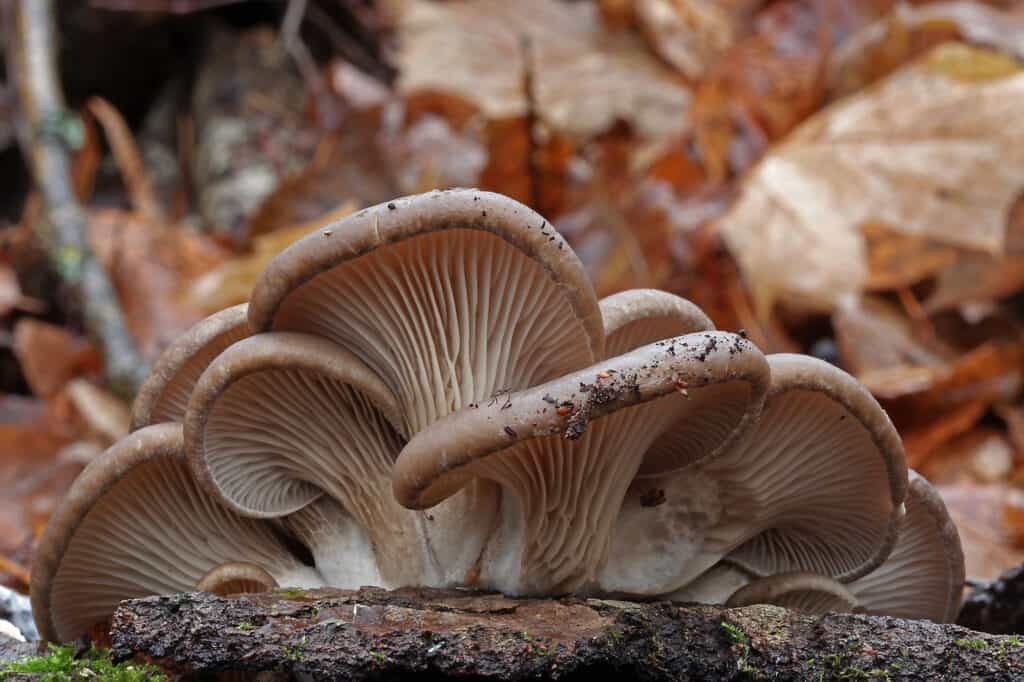
Oyster mushrooms (pictured) have a distinct bouncy texture that makes them easy to identify.
©NK-55/Shutterstock.com
4. Dryad’s Saddle Mushrooms
Dryad’s saddle mushrooms are classified as polyporus squamosus. Instead of growing in the ground, these scaly polypores, also known as “Pheasant‘s Back Mushrooms,” are discovered growing on the sides of dead hardwood trees and stumps. This fungus has a highly distinctive flavor and aroma that is similar to watermelon or cucumber. When the mushrooms are fresh and soft, they have the finest flavor; but, as they age, they become chewy and rough. The outer ring of the dryad’s saddle mushroom should still be pretty soft and edible if you discover an older example.
The black scale patterns on the top of the mushroom make dryad’s saddle a simple polypore to recognize. The mushroom has distinctively big honey-comb pores on the underside. When cooked or added to broths, the mushrooms are rather tasty. To discover them when foraging, keep your gaze upwards rather than toward the ground.
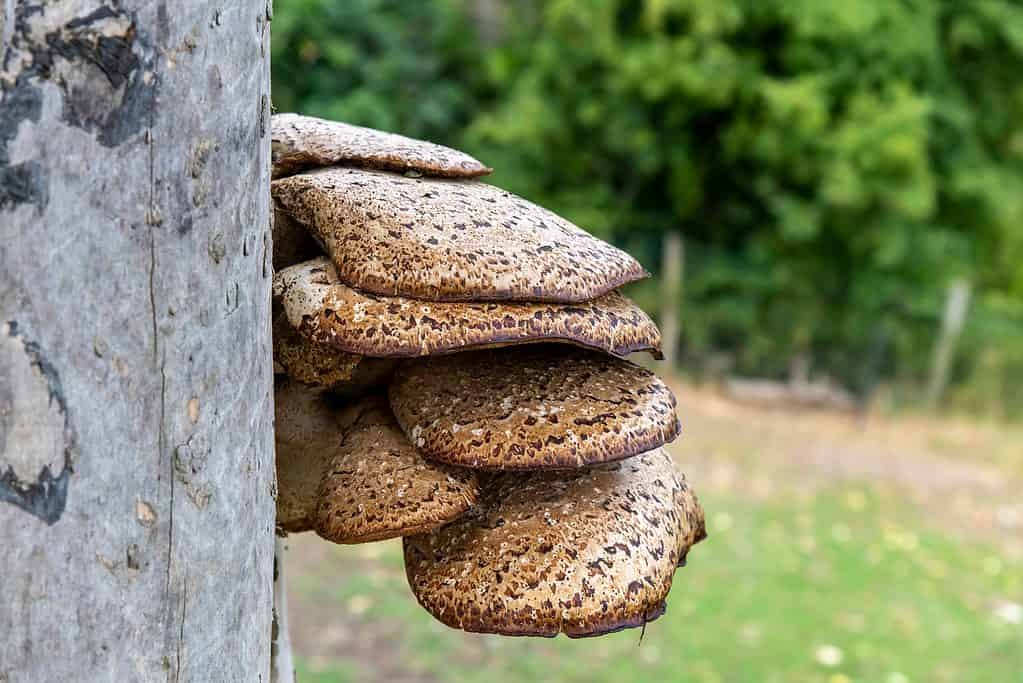
The dryad’s saddle mushroom (pictured) has beautiful speckled patterns on its caps that make them easy to identify.
©365 Focus Photography/Shutterstock.com
5. Turkey-Tail Mushrooms
Turkey-tail mushrooms are classified as trametes versicolor. One of the most prevalent mushrooms in the forest, turkey-tail mushrooms are found all around the world. There are no known toxic look-alikes, and they may grow on practically any sort of wood. However, they are also among the most costly medicinal mushrooms to purchase, so finding them naturally may be preferable.
Turkey-tail mushrooms mature and become a little drier, especially after being picked. They should still be slightly pliable even after drying because they are so thin. The turkey-tail mushroom may be identified if the mushrooms are stiff and firm.
Turkey-tail mushrooms are safe to consume and can also be used as a supplement. It’s also a medicinal fungus with an astonishing array of advantages. It has a number of potent antioxidants and other substances that might help strengthen your immune system and possibly fight some malignancies.
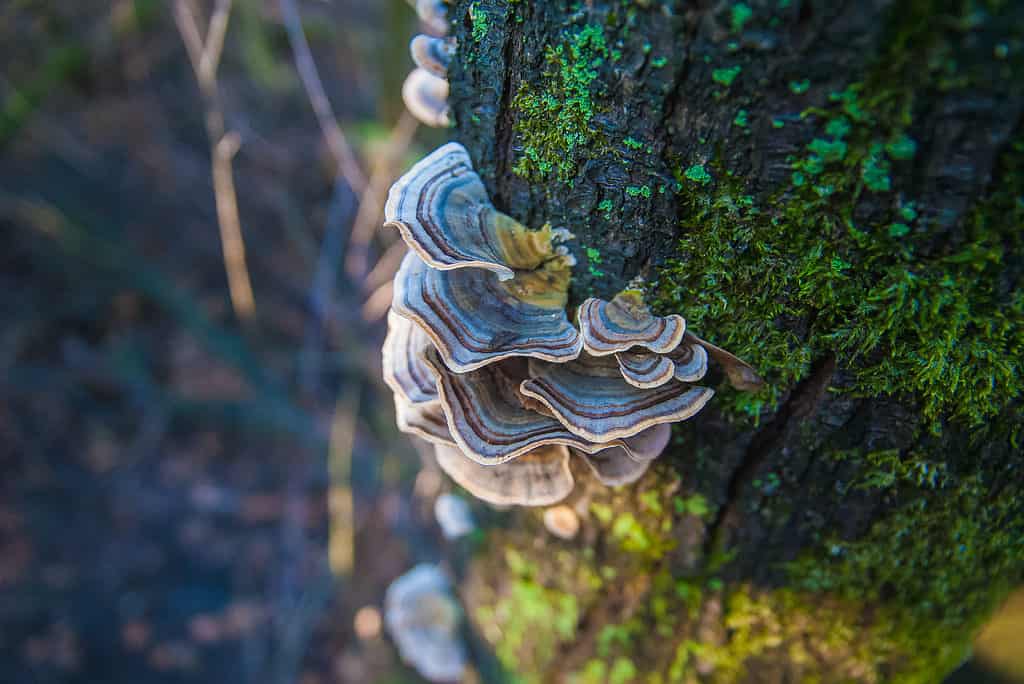
A turkey-tail mushroom (pictured) has the shape and texture of a turkey’s tail foliage, so it is easy to find.
©Slobodan Cvetkovic/Shutterstock.com
6. Hen of the Woods Mushrooms
Hen of the woods mushrooms are classified as grifola frondosa. They are one of the most popular mushrooms in China and Japan because of both their delectable flavor and purported medical benefits. The potential health advantages of this mushroom are currently being studied by scientists. They are used to treat diabetes and high blood pressure in Chinese medicine.
In general, late August through November are the best months to locate hen of the woods mushrooms. However, you may readily find them blooming in the spring in various areas. However, they may appear in just about any place that has a temperate forest environment. So be vigilant the next time you go hiking in the upcoming spring.
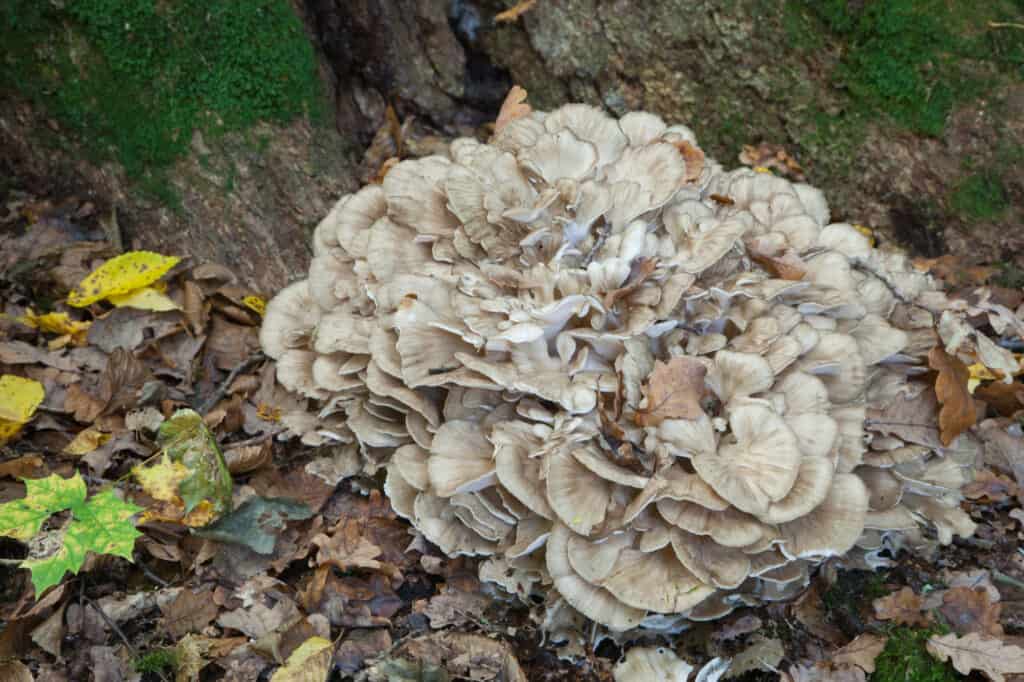
Hen of the woods mushrooms (pictured) can grow in very large patches that are easy to spot when foraging.
©Aleksander Bolbot/Shutterstock.com
7. Wood Ear Mushrooms
Wood ear mushrooms are classified as auricularia auricula-judae. Although they may be used in a broad variety of cuisines, these jiggly ear-shaped mushrooms are typically utilized in Asian cuisine. The ear-shaped wood ear mushroom is a jelly fungus that often grows on dead branches, limbs, and twigs rather than in soil like many other kinds of mushrooms.
The optimum time to forage for this edible fungus is just after a rainstorm. The wood ear mushroom will typically shrivel up like a raisin if it has been too long dry. However, this mushroom is difficult to overlook when foraging due to its unusual form.
These glistening mushrooms are rich in B vitamins and copper. Wood ear provides 30% of your daily copper needs in one meal. The polysaccharides in the wood ear mushroom might strengthen the immune system as well. This particular mushroom does very well in stir-fries and soups, making it a versatile edible mushroom to forage.
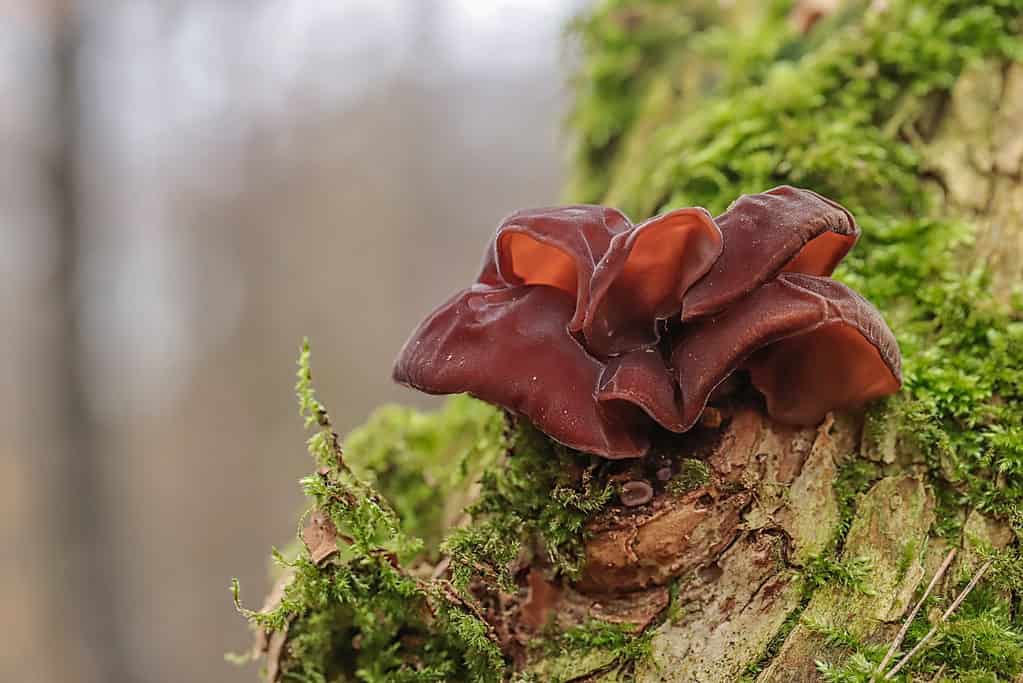
The wood ear mushroom (pictured) has a gelatinous texture that is easy to spot, as they don’t look like the traditional mushroom cap.
©Marek Mierzejewski/Shutterstock.com
8. Shiitake Mushrooms
Shiitake mushrooms are classified as lentinula edodes. Shiitake is mostly grown in China and Japan, two nations in east Asia. In the spring and fall, the mushroom grows on dead trees. Although it grows in woods all over the world, this mushroom is most famous for having been originally grown in Japan centuries ago.
The umbrella-shaped top of the shiitake is tan to brown in hue. The pale, cream-colored gills on the underside of the cap are surrounded by rolling margins that descend and inward. Look for two to six-inch caps on the sides of rotting wood, especially chestnut and oak, while foraging for this species.
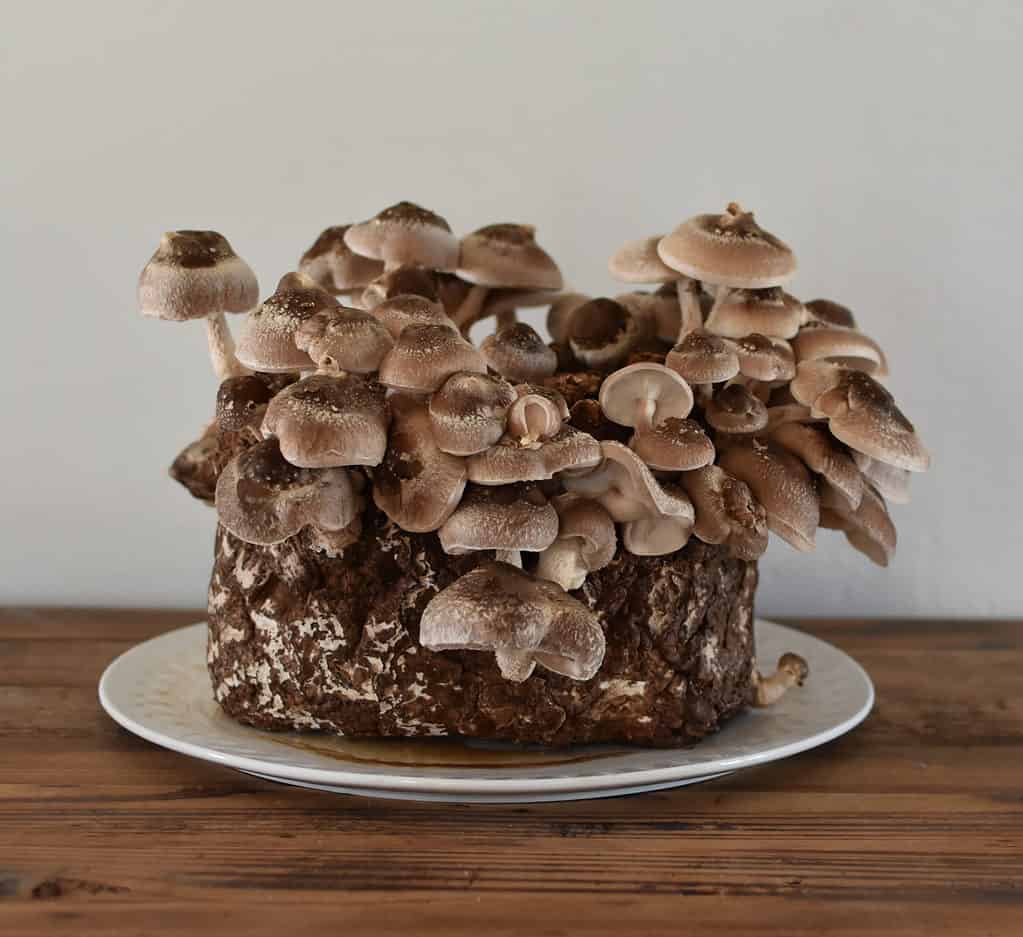
Shiitake mushrooms growing on a plate
©Mary Elise Photography/Shutterstock.com
9. Wine-Cap Stropharia
Wine-cap stropharia are classified as stropharia rugosoannulata. On treks through forests and woodlands, the wine-cap mushroom can be rather frequent to come upon. They are widespread in Europe and North America, but they are now a well-established invasive species in Australasia as well.
Mulches and soil coated in rich organic debris are ideal growth environments for the majority of mushrooms. However, wood shavings are preferred in particular by wine-cap mushrooms. Because of the prevalence of wood waste in forestry regions, they can be seen there frequently. You could also find it growing on mulches in the margins of gardens or even urban parks because of its fondness for wood chips. Use this mushroom in risotto or recipes with meat.
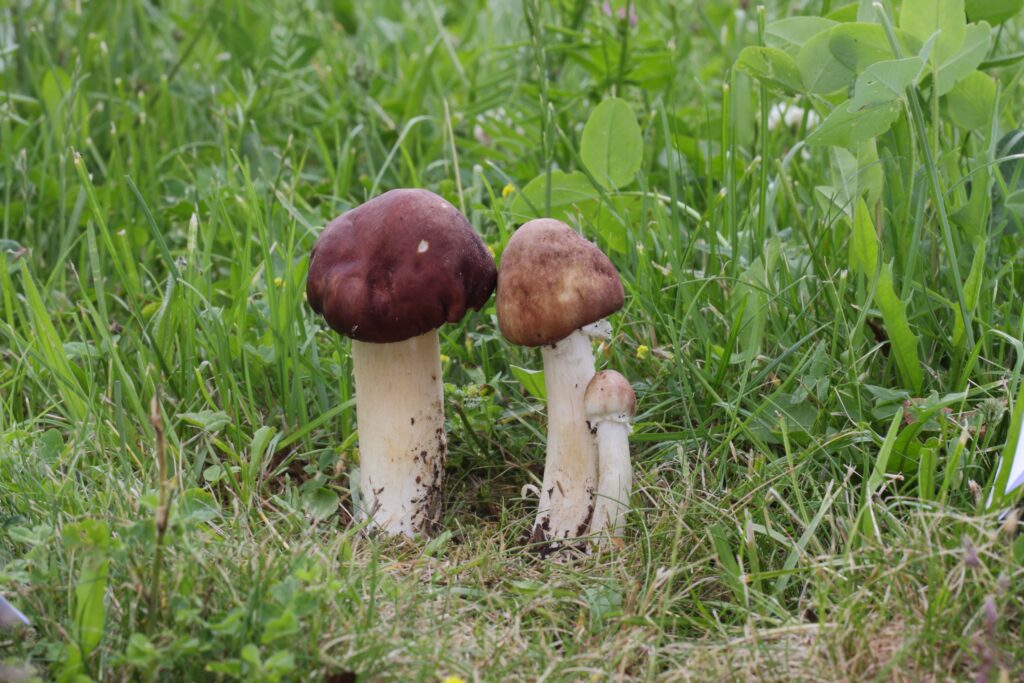
The wine-cap mushroom (pictured) can be found in forests and woods as well as city and residential parks in North America.
©Petr Muckstein/Shutterstock.com
10. Mica Cap Mushrooms
Mica cap mushrooms are classified as coprinellus micaceus. Mica caps prefer buried timber, logs, and stumps in particular. The majority of the time, the mushrooms are found on or next to wood. Even when trees appear to be in good health, they can occasionally be found near their bases. Unusual among mushrooms, the mica cap is not particular about the kind of wood it decomposes. Mica caps thrive in urban environments and are a common appearance in gardens and other cultivated places, despite having evolved to exist in woods.
Despite having a mild flavor, the mica cap is regarded as an edible fungus. Only specimens that haven’t started to liquefy should be collected. Mica caps must be prepared and consumed nearly immediately after being harvested since, after three hours, they start to deliquesce or disintegrate into an inky black liquid.

Mica cap mushrooms (pictured) grow near decaying wood and can be found growing directly from the soil.
©Kazakov Maksim/Shutterstock.com
Summary of 10 Wild Mushrooms Found in Spring
| Rank | Mushroom |
|---|---|
| 1 | Morel Mushrooms |
| 2 | Chicken of the Woods Mushrooms |
| 3 | Oyster Mushrooms |
| 4 | Dryad’s Saddle Mushrooms |
| 5 | Turkey-Tail Mushrooms |
| 6 | Hen of the Woods Mushrooms |
| 7 | Wood Ear Mushrooms |
| 8 | Shiitake Mushrooms |
| 9 | Wine-Cap Stropharia |
| 10 | Mica Cap Mushrooms |
The photo featured at the top of this post is © Tomasz Czadowski/Shutterstock.com
The information presented on or through the Website is made available solely for general informational purposes. We do not warrant the accuracy, completeness, or usefulness of this information. Any reliance you place on such information is strictly at your own risk. We disclaim all liability and responsibility arising from any reliance placed on such materials by you or any other visitor to the Website, or by anyone who may be informed of any of its contents. None of the statements or claims on the Website should be taken as medical advice, health advice, or as confirmation that a plant, fungus, or other item is safe for consumption or will provide any health benefits. Anyone considering the health benefits of particular plant, fungus, or other item should first consult with a doctor or other medical professional. The statements made within this Website have not been evaluated by the Food and Drug Administration. These statements are not intended to diagnose, treat, cure or prevent any disease.
Sources
- Kyle Pearce, Available here: https://www.inaturalist.org/guides/10719
- Adrian White, Available here: https://foodal.com/knowledge/paleo/morels-and-wild-mushrooms/
- (1970)
FAQs (Frequently Asked Questions)
Is it difficult to find mushrooms in spring?
Not at all. Which summer or autumn are ideal seasons for mushroom foraging, mushrooms and fungi like to grow all year round.
What part of spring is best for mushroom foraging?
Between April and early May is the ideal time period for foraging mushrooms in spring, at least in North America.
What are the best mushrooms to forage in spring?
Oyster, wood ear, and shiitake mushrooms are popular gourmet mushrooms to forage for in spring.
Thank you for reading! Have some feedback for us? Contact the AZ Animals editorial team.







